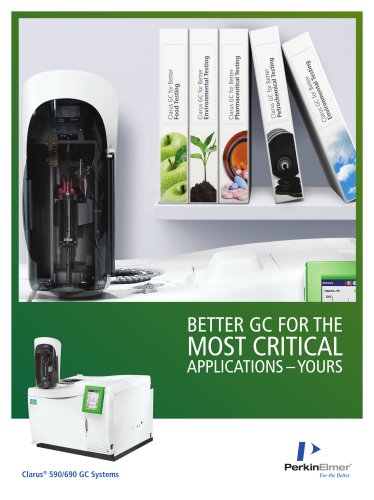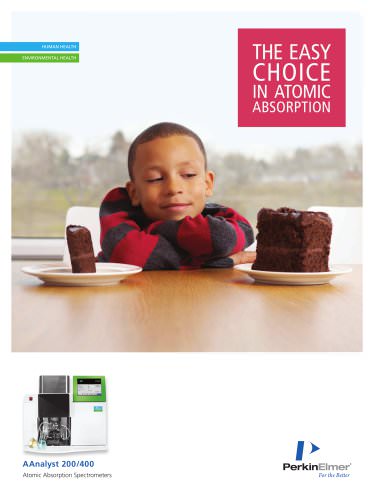 Website:
PerkinElmer
Website:
PerkinElmer
Group: PerkinElmer
Catalog excerpts

WATER and environmental analysis LAMBDA XLS and XLS+ UV/Vis Spectrophotometers Author: Aniruddha Pisal
Open the catalog to page 1
TABLE OF CONTENTS Introduction. . . . . . . . . . . . . . . . . . . . . . . . . . . . . . . . . . . . . . . . . . . . . . . . . . . . . . 2 The LAMBDA XLS UV/Vis Spectrophotometer. . . . . . . . . . . . . . . . . . . . . . . . . . . . . 4 Determination of Ammonia-Nitrogen by Nessler Reaction Method 4500-NH3 A-C. . . . . . . . . . . . . . . . . . . . . . . . . . . . . . . . . . . . . . . . . . . . . 8 . Determination of Hexavalent Chromium - Diphenylcarbazide Method 3500-CR. . . . . . . . . . . . . . . . . . . . . . . . . . . . . . . . . . . . . . . . . . . . . . . . . 13 Determination of...
Open the catalog to page 2
INTRODUCTION UV/Vis spectroscopy is an important analytical technique in modern water analysis. Many cations and anions in water can be determined with high selectivity and sensitivity. The common principle of water analysis is that the sample is mixed with reagents, which react specifically with the constituent to be analyzed. In most cases a colored compound or complex is formed. The intensity of the color is a measure for the concentration and can be quantified using UV/Vis Spectroscopy. Here the attenuation of radiation of a specific wavelength can be measured and a relation between...
Open the catalog to page 3
Introduction Deviations from the Beer-Lambert law are caused by two different effects: • Chemical influences, like changes of ionic strength or pH value, electrostatic interactions and associations, dissociations or polymerizations, may cause deviations from the Beer-Lambert law. Such influences can be controlled to a certain extent by modification of the reaction conditions. • Instrumental influences like insufficient dispersion of the beam (stray radiation) cause a deviation of the Beer-Lambert law. Because stray radiation is independent of sample concentration its relative effect is...
Open the catalog to page 4
The LAMBDA XLS UV/Vis Spectrophotometer PerkinElmer® LAMBDA XLS and XLS+ UV/Vis spectrophotometers have been specially designed for academic and industrial laboratories that require smallfootprint, dedicated instrumentation for a wide range of applications and offers complete and easy to use facilities for quantitative analysis. The instrument includes built-in basic methods for spectra recording, wavelength programming, kinetics and quantitative analysis. These basic methods can be modified by the user according to specific analytical demands and can be stored as ready-to-use methods in...
Open the catalog to page 5
LAMBDA XLS+ UV/Vis Spectrophotometer Performing Analyses: Analytical methods including calibration curves, once defined, can be stored and are ready for use with one keystroke. With this method concept all photometric methods as recommended by national regulations can be performed reliably and easily. The analytical protocols described in this booklet are instructions for the determination of different water constituents. These instructions are specifically targeted for use with the LAMBDA XLS/XLS+ UV/Vis spectrophotometers from PerkinElmer. When a special water analysis is to be performed,...
Open the catalog to page 6
LAMBDA XLS+ UV/Vis Spectrophotometer Regulatory Requirements: UV/Vis spectroscopy is an important analytical technique used for the determination of many water constituents. National regulations in many countries prescribe the use of UV/Vis spectroscopy for the analysis of water constituents as listed in Table 1. The present publication describes important analytical methods using UV/Vis spectroscopy. All methods are based on the U.S. EPA standard methods. Most of the limits and standard values listed in Table 1 can be measured using LAMBDA XLS+ UV/Vis spectroscopy with the methods...
Open the catalog to page 7
LAMBDA XLS+ UV/Vis Spectrophotometer Literature [1] Resource conservation and recovery act methods from S-846 – “Test Methods for Evaluating Solid Waste, Physical/Chemical Methods”, 3rd ed., U.S. GPO, Washington, DC, 1987. [2] “Methods for Chemical Analysis of Water and Waste”. Environmental Monitoring Systems Laboratory (EMSL), Cincinnati, OH, 1983. [3] “Standard Methods for the Examination of Water and Wastewater” 18th edition, American Public Health Association, 1992. [4] 40 CFR Part 136 Appendix B - Definition and Procedure for the Determination of Method Detection Limit. [5] “Water and...
Open the catalog to page 8
Determination of Ammonia-Nitrogen by Nessler Reaction Method 4500-NH3 A-C Introduction: Ammonia can occur in all kinds of surface waters, in some ground waters and in wastewaters from industry and households. Whether ammonia nitrogen is found as NH4+ ion or as NH4OH or NH3 depends on the pH value of the water. Applications: This method is suitable for determining ammonia - nitrogen in drinking, surface and saline waters, domestic and industrial wastes in the range from 0.05 mg/L to 1.0 mg/L NH3-N. Principle of the Method: The sample is buffered at a pH of 9.5 with a borate in order to...
Open the catalog to page 9
Determination of Ammonia-Nitrogen by Nessler Reaction - Method 4500-NH3 A-C Apparatus and Reagents: pH Meter Boric acid solution Volumetric flasks, volume 50 mL Sodium hydroxide solution 0.1 mol/L Volumetric flasks, volume 100 mL Sodium tetraborate solution 0.025 mol/L Hot plate for distillation Borate buffer, pH 9.5 Boiling chips Nessler reagent Erlenmeyer flasks, volume 100 mL Ammonia-nitrogen stock solution (1 g/L NH3-N) Eppendorf micropipettes Ammonia-nitrogen working solution 0.01 g/L NH3-N Nessler tubes Sodium thiosulfate (1/35 mol/L) or sodium arsenite Distillation apparatus Sodium...
Open the catalog to page 10
Determination of Ammonia-Nitrogen by Nessler Reaction - Method 4500-NH3 A-C Introduction: • Prepare a series of reference solutions, as shown in Table 1, by pipetting suitable volumes of the ammonianitrogen working solution in Nessler tubes with markings at 50 mL as follows, • Make up to the mark with distilled water. (The procedure was followed by assuming 50 mL of sample volume.) Table 1: Calibration reference solutions. Amount of Ammonia-nitrogen ( NH3-N ) working solution in 50 mL Concentration (mg/L) NH3-N --- 0.0 Reference 1 0.5 mL 0.1 Reference 2 1.0 mL 0.2 Reference 3 2.0 mL 0.4...
Open the catalog to page 11All PerkinElmer catalogs and technical brochures
-
Cannabis Testing Solutions
12 Pages
-
STA 8000
4 Pages
-
ScanRI
2 Pages
-
Thermal Analysis
3 Pages
-
Ultra Clean Gas Filters
10 Pages
-
TurboMatrix
8 Pages
-
Clarus® 590/690 GC Systems
8 Pages
-
Titan MPS Microwave
4 Pages
-
PinAAcle 500
8 Pages
-
TurboMatrix
8 Pages
-
Flexar SQ 300 MS Brochure
8 Pages
-
Atomax Brochure
2 Pages
-
NexION 350 ICP-MS Brochure
12 Pages
-
Ultra Clean Gas Filters Catalog
10 Pages
-
AxION iQT GC/MS/MS
4 Pages
-
AxION 2 TOF
8 Pages
-
AxION DSA
8 Pages
-
AxION eDoor SQ
2 Pages
-
Flexar SQ 300 MS
8 Pages
-
Flexar PDA Plus Detector
2 Pages
-
NexION 300 ICP-MS Brochure
12 Pages
-
AAnalyst 200/400 Brochure
12 Pages
-
XRD Detector Series
2 Pages
Archived catalogs
-
FLEXAR™ Liquid Chromatography
12 Pages


























































